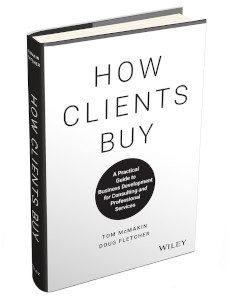Executives discuss how clients buy services
Posted by Elena del Valle on July 11, 2019

How Clients Buy
Photos: Carlie Auger
Convinced that selling professional services is different from selling products Tom McMakin and Doug Fletcher dedicated a year to writing and publishing How Clients Buy A Practical Guide to Business Development for Consulting and Professional Services (Wiley, $29), a guide to business development for expert services such as accountants, lawyers, human resources consultants and strategy advisors.
“Wiley has done a nice job of supporting the book with online sellers and by offering rights overseas,” McMakin said by email when asked how they marketed the 262-page book. “Augmenting that, we launched a How Clients Buy website, distributed complementary copies to key influencers in the professional services industry, and placed books with airport booksellers.”

Doug Fletcher, co-author, How Clients Buy
“How Clients Buy was my first book, but hopefully not my last,” Fletcher said by email when asked about the book. “It’s been a wonderful experience. One of the highlights of my professional career.”
The hardcover book, published in 2018, is divided into 19 chapters and four main sections: The Problem, Obstacles, How Clients Buy and Putting the Seven Elements to Work.
“Doug and I believe that high end, highly customized expert services are sold to clients in very different ways than, say, an iPhone, which is sold on features, attributes, and price,” McMakin said. “Indeed, it is not even useful to think about selling services. A better paradigm is to think about ‘how clients buy.’ We concluded that most clients engage with would-be consultants by way of relationships, referrals, and reputation. The question that fascinated us, both solo practitioners and members of large consulting firms, is how one systematically drives those three R’s.”
“The trend toward fewer companies (which are larger and able to serve global markets) is fueling double-digit growth in the $1.7 trillion global professional services market as companies seek to outsource (either nearshoring or offshoring) non-core functions,” McMaking said to a question about how the offshoring of professional services jobs and the reduction in the number of publicly traded companies impact professional services in the United States. “Large companies face two challenges: they need to compete in a global war for top talent, and they need to remain agile to be able to pivot strategically as disruptive forces undermine markets and business models. By hiring just-in-time senior leadership in the form of a consulting or advisory contract, companies can sustain and build competitive advantage in a fast-moving, ever-changing marketplace.
The future for those who offer specialized insight born of sector specific experience is strong. In the course of our research, we were told by rainmakers that expert service practice areas are growing more global even as they are becoming more focused. A company no longer hires a local accountant to do all their work, but instead hires different accountants, who may be geographically disbursed to help them solve specific problems where they have world-class domain expertise.”

Tom McMakin, co-author, How Clients Buy
Marketers describe Generation Z as the most diverse generation in our country’s history. When asked in what ways, if any, they anticipate this will affect how and what clients buy, McMakin replied, “Just like the country is becoming more diverse, so too is the world of expert services. To succeed, professional service firms need to shrink the pond and narrowcast to specific groups of people where their experience and expertise most applies. This can be a step-up for bands of experts who might have found themselves left out of the corporate mainstream in the past. Not only can they speak to the advantage inherent to their diverse backgrounds – think consultants who rolled out of the Kenyan banking sector advising multinationals on east African trade – but true expertise, informed by a long set of relevant experiences and thoughtful reflection – floats free of the kind of constraints that have hindered diverse professionals in the past. At the same time, increased diversity in large companies is driving a thirst for more diverse input into those companies opening the door to groups of consultants with different and valuable points of view.”
Fletcher said, “With regard to Gen Z – one other point we make in the book is how clients buy today vs. how they might buy in the future. Today, generally speaking, decision makers in larger organizations are not Gen Z – or millennials. Today’s clients still prefer to hire people that they know, respect and trust or who come highly recommended by a colleague. Tomorrow’s leaders may be more willing to buy expert services more digitally – using online reviews, Skype, Zoom, and other digitally formed relationships. It’s hard to say. With today’s large expert services projects – often in the hundreds of ‘000s or millions $, these are purchased typically after long, face to face relationships are established. How clients buy ten or twenty years from now may be very different?”
McMakin is chief executive officer and partner of Profitable Ideas Exchange (PIE). Before joining PIE, he was a co-founder and managing director with Orchard Holdings Group, a private equity firm based in Cincinnati, Ohio.
Fletcher splits his time between teaching at Montana State University’s Jake Jabs, and speaking, writing, and coaching about business development in professional services and consulting. He serves on the board of directors of The Beacon Group in Portland, Maine.

Click to buy How Clients Buy










